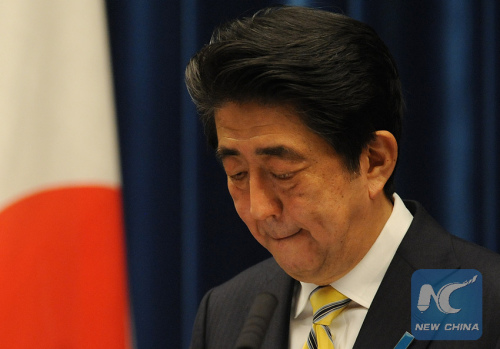
Japanese Prime Minister Shinzo Abe bites his lips during a press conference at his official residence in Tokyo, Japan, Nov. 21, 2014. (Photo: Xinhua/Stringer)
The Japanese government on Wednesday said that the country's economy increased an annualized 1.7 percent in real terms in the first quarter of 2016 and that this corresponded to a 0.4 percent growth from the previous quarter, attributing the increase to recovering private consumption.
However, the readings are not as positive as they look. In nominal terms, domestic demand dragged down GDP by 0.2 percent and private consumption slipped 0.1 percent in the reporting period, marking the second consecutive quarter of decrease.
The real term GDP is calculated based on the price factor in 2005, while the nominal GDP is adjusted based on the price factor in the first quarter of 2016. It means that Japan is actually still mired in deflation as prices in the reporting period decreased compared to that of 2005.
Three and a half years on, Prime Minister Shinzo Abe's economy policy mix dubbed "Abenomics" has failed to propel Japan out of prolonged deflation, despite the central bank's ultra-loose monetary easing moves and the negative interest rate adopted recently by the bank.
The Japanese yen's rapid appreciation and volatile stock market here triggered by an unexpected sharp plunge in oil prices since earlier this year exposed the weakness of "Abenomics" against a backdrop of a changing global economic situation.
The key issue is that "Abenomics" from the beginning wrongly estimated the entire Japanese business environment in which business leaders are hesitant when it comes to increasing investments, due to the country's decade-long stagnancy and, therefore, when "Abenomics" was introduced, it was impaired by its own self-constructed paradoxes.
WEAKER YEN HELPS BIG COMPANIES AT COST OF SMALL ENTERPRISES
One of the fundamentals of "Abenomics" is to issue more currency so as to depreciate the yen's value in order to improve competitiveness of Japanese goods. A weaker yen has helped many export-oriented big companies and spurred the skyrocketing of the stock market here since the policy mix was introduced in early 2013.
However, behind the bright earning reports of big companies are an increasing number of bankrupted medium and small-sized enterprises that heavily depend on imports. The yen's retreat helped push up the prices of imported materials.
According to the Teikoku Databank, as of December 2015, raw materials for the wholesale sector jumped 52.9 percent on year, while the cost of clothing materials surged 71.4 percent on year. The number of bankruptcies related to the yen's depreciation increased in 2015 for the second straight year.
Monthly reports by the databank on Japanese bankrupted enterprises also showed that more than 50 percent of Japanese businesses that went bankrupt are medium-sized and small companies that account for 98 percent of all Japanese enterprises.
"This is endemic of the failure of 'Abenomics.' The prime minister's policies were tailor-made to support big business, whereas economists maintain that it's the smaller industrial businesses (not blue chips) that have for decades been propping up Japan's economy. The business failure rate of small and medium-sized businesses is a very worrying harbinger of what's in store for the broader economy," said David McLellan, a professor emeritus of postgraduate Asian Studies.


















































